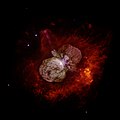Няйф:Eta Carinae.jpg

Тя анокс ванондомать оцюлмац: 600 × 599 пиксельхть. Иля келептема:240 × 240 пиксельхть | 480 × 480 пиксельхть | 769 × 768 пиксельхть | 1025 × 1024 пиксельхть | 2015 × 2013 пиксельхть.
Васень файла (2015 × 2013 пикселхть, файлть сталомоц (мароц): 163 КБ, MIME типоц: image/jpeg)
Файлать пингелувксоц
Люпштак шить/пингть лангс ся пингть файлать няеманди.
| Ши/Пинге | Анцяйня | Оцюлмац | Сувай | Мяльполаткс | |
|---|---|---|---|---|---|
| тяниень | 09:41, 18 Ацамковста 2017 |  | 2015 × 2013 (163 КБ) | The NMI User | Reverted to version as of 14:14, 1 May 2008 (UTC) |
| 14:45, 13 Васеньковста 2017 |  | 3000 × 2998 (1,18 МБ) | Leogorgon | larger file size | |
| 14:14, 1 Панжиковста 2008 |  | 2015 × 2013 (163 КБ) | Vol de nuit | {{Information |Description=(NASA News Release) A huge, billowing pair of gas and dust clouds are captured in this stunning NASA Hubble Space Telescope image of the supermassive star Eta Carinae. Using a combination of image processing techniques (ditheri |
Файлань тевс нолдама
Аш фкявок лопа, кона сюлмаф тя файлать мархта.
Файлань эрьва мезень тевс нолдама
Тя файлась тевс нолдави стама викитнень эса:
- da.wikipedia.org-са тевс нолдама
- en.wikipedia.org-са тевс нолдама
- Star
- Eta Carinae
- Wikipedia:Selected anniversaries/March 11
- Wikipedia:Today's featured article/March 2017
- Wikipedia:WikiProject Wikipack Africa Content/Wikipedia:Showcase
- Wikipedia:WikiProject WikiFundi Content/Eta Carinae
- Wikipedia:Today's featured article/requests/Eta Carinae
- Wikipedia:Today's featured article/March 12, 2017
- Wikipedia:Main Page history/2017 March 12
- Wikipedia:WikiProject WikiFundi Content/Wikipedia:Showcase
- Wikipedia:Main Page history/2022 March 11
- Wikipedia:Main Page history/2022 March 11b
- Wikipedia:Main Page history/2023 March 11
- Wikipedia:Main Page history/2023 March 11b
- User:2003 LN6/sandbox/Eta Carinae variable
- List of luminous blue variable stars
- en.wikiversity.org-са тевс нолдама
- User:Marshallsumter/Radiation astronomy2/Visuals
- User:Marshallsumter/Radiation astronomy2/Violets
- Stars/Astronomy
- User:Marshallsumter/Radiation astronomy2/Violets/Quiz
- Stars/Sun/Astronomy/Quiz
- User:Marshallsumter/Radiation astronomy/Courses/Principles/Hourly 2
- User:Marshallsumter/Radiation astronomy/Courses/Principles/Final quiz
- Draft:Original research/Io/Quiz
- Titan/Quiz
- Stars/Solar systems/Quiz
- Moon/Quiz
- Earth/Quiz
- User:Marshallsumter/Radiation astronomy/Colors/Quiz
- Volcanoes/Io/Quiz
- Stars/Violets
- User:Marshallsumter/Radiation astronomy2/Stars
- Stars/Violets/Quiz
- es.wikipedia.org-са тевс нолдама
- fr.wikipedia.org-са тевс нолдама
- hi.wikipedia.org-са тевс нолдама
- it.wikibooks.org-са тевс нолдама
- la.wikipedia.org-са тевс нолдама
- mk.wikipedia.org-са тевс нолдама
- ms.wikipedia.org-са тевс нолдама
- my.wikipedia.org-са тевс нолдама
- oc.wikipedia.org-са тевс нолдама
- ru.wikipedia.org-са тевс нолдама
- sk.wikipedia.org-са тевс нолдама
- sr.wikipedia.org-са тевс нолдама
- th.wikipedia.org-са тевс нолдама
Ванондомс тя файлать нолдаманц сембе вастова.
